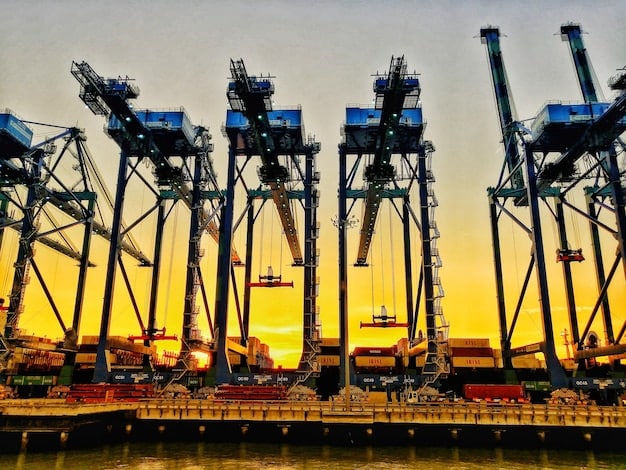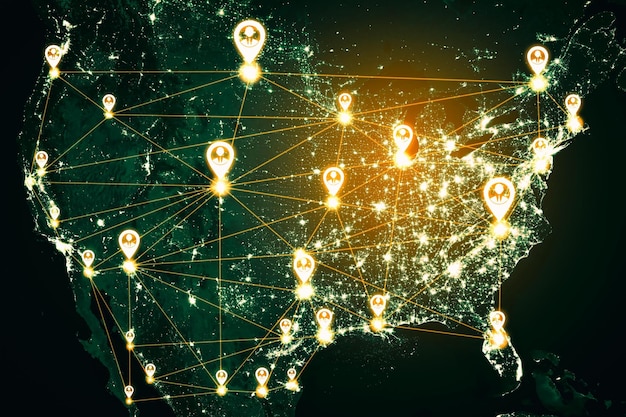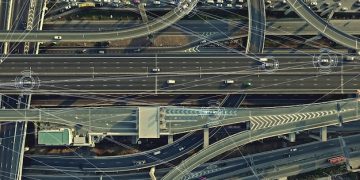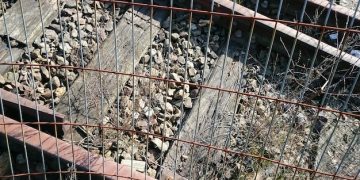Infrastructure Bill: $550 Billion Reshapes Key US Industries

The $550 billion investment from the Infrastructure Bill is poised to significantly transform critical American sectors, fostering widespread innovation, job creation, and economic revitalization across transportation, energy, broadband, and water infrastructure, ultimately enhancing long-term national competitiveness.
The United States stands at a pivotal moment. With the recent passage of the Bipartisan Infrastructure Law, an unprecedented $550 billion investment will reshape key industries across the nation, promising a transformative impact on everything from transportation networks to digital connectivity. This legislation isn’t just about repairing roads and bridges; it’s a strategic move to modernize America’s foundational systems, create millions of jobs, and position the country for sustained economic growth in the 21st century.
The Grand Vision: What the Infrastructure Bill Aims to Achieve
The Infrastructure Investment and Jobs Act (IIJA), often referred to simply as the infrastructure bill, represents the largest long-term investment in American infrastructure and competitiveness in nearly a century. Its core objective is multifaceted: to rebuild America’s dilapidated infrastructure, create good-paying jobs, and position the economy for long-term growth and resilience. This isn’t merely about maintenance; it’s about modernization and adaptation to future challenges, including climate change and digital transformation.
The bill allocates substantial funds across various critical sectors, recognizing that interconnected and efficient infrastructure is the backbone of a thriving economy. From improving the efficiency of supply chains to enhancing public safety, the investments are designed to have a cascading positive effect on virtually every aspect of American life. The emphasis is on projects that deliver tangible benefits, such as reduced commute times, cleaner air and water, and greater access to high-speed internet.
Understanding the bill’s objectives requires a look at its historical context. Decades of underinvestment have left much of the nation’s infrastructure in a state of disrepair, leading to inefficiencies, safety concerns, and reduced competitiveness. The IIJA seeks to reverse this trend by providing dedicated funding streams for projects that have been neglected. This holistic approach aims to address systemic issues rather than merely patchwork solutions, ensuring long-term dividends for communities nationwide.
Targeted Investments for Maximum Impact
The legislation identifies several key areas for significant investment. These targets were chosen based on a comprehensive assessment of national needs and economic opportunities. By directing funds towards these specific sectors, the bill aims to maximize its impact on economic growth and societal well-being.
-
Transportation Modernization: Overhauling roads, bridges, public transit, and rail systems to improve efficiency and safety.
-
Clean Energy Transition: Investing in renewable energy, grid modernization, and electric vehicle charging infrastructure.
-
Broadband Expansion: Ensuring affordable high-speed internet access for all Americans, bridging the digital divide.
-
Water and Wastewater Systems: Upgrading and replacing aging water pipes and treatment facilities to ensure clean drinking water.
These targeted investments are designed to create a ripple effect, stimulating innovation within various industries and fostering new job opportunities across the skilled trades and emerging technologies. The bill’s framework also prioritizes a “buy American” policy, aiming to strengthen domestic supply chains and manufacturing capabilities, further reinforcing the economic benefits within the country.
In essence, the grand vision of the Infrastructure Bill is to lay a robust foundation for America’s future. It’s about building a more connected, sustainable, and equitable nation, where modern infrastructure supports a dynamic economy and improves the quality of life for all citizens. The scope is ambitious, reflecting a commitment to long-term progress and an understanding that strong infrastructure is critical to national prosperity.
Transportation and Logistics: Paving the Way for Efficiency
The modernization of America’s transportation and logistics networks stands as a cornerstone of the Bipartisan Infrastructure Law’s objectives. With roads, bridges, and public transit systems often operating beyond their intended lifespan, the bill channels significant funds to upgrade and enhance these vital arteries of commerce and daily life. This investment is not just about repairs; it’s about strategically improving connectivity, reducing congestion, and bolstering the efficiency of supply chains that underpin the entire economy.
Substantial allocations are directed toward federal-aid highway programs, bridge repair and replacement, and major investments in public transportation. The goal is to create a seamless and resilient transportation system that can meet the demands of a growing economy and an evolving climate. This includes funding for innovative projects like smart roads, which can leverage technology to improve traffic flow and safety, and the expansion of electric vehicle charging infrastructure, which signals a move towards a greener transportation future.
Furthermore, the bill addresses the long-neglected rail system, committing significant resources to Amtrak and freight rail lines. Enhanced rail infrastructure can reduce reliance on trucking for long-haul freight, offering a more environmentally friendly and often more efficient alternative. This multifaceted approach to transportation aims to unlock economic potential by making it easier, faster, and cheaper to move goods and people across the country, thereby reducing costs for businesses and improving productivity.
Key Transportation Areas of Impact
The legislation’s focus extends beyond basic repairs to encompass strategic enhancements that will yield long-term benefits across the transportation ecosystem. These investments are designed to address bottlenecks, improve safety, and foster innovation within the sector.
-
Roads and Bridges: Dedicated funds for maintenance, repair, and construction of highways and structurally deficient bridges, reducing travel delays and improving safety.
-
Public Transit: Significant investments in modernizing transit fleets, expanding routes, and improving accessibility, encouraging ridership and reducing urban congestion.
-
Rail and Ports: Allocations for upgrading rail infrastructure, improving port efficiency, and strengthening supply chains for both freight and passenger travel.
The modernization of transportation and logistics infrastructure inevitably creates a surge in demand for materials, equipment, and skilled labor. Construction companies, engineering firms, and material suppliers stand to benefit directly from the influx of projects. Beyond these immediate impacts, improved transportation networks lead to reduced operational costs for businesses, faster delivery times, and enhanced market access, stimulating economic activity across diverse sectors. The long-term efficiency gains contribute to national competitiveness and foster a more dynamic economy.

The ripple effect of these investments is profound. Businesses that rely heavily on logistics will experience reduced supply chain disruptions and lower transportation costs. This can translate into more competitive pricing for consumers and healthier profit margins for companies. For individuals, better public transit means greater accessibility to jobs and services, while safer roads reduce accidents and commute times. Ultimately, the transportation and logistics investments within the Infrastructure Bill are about building a more efficient, resilient, and interconnected America, paving the way for sustained economic prosperity.
A Sustainable Future: Energy and Utilities Transformation
The Infrastructure Bill dedicates substantial resources to reshape America’s energy landscape and critical utilities, aiming for a cleaner, more resilient, and sustainable future. This section of the bill focuses heavily on modernizing the electric grid, fostering renewable energy deployment, and upgrading water infrastructure, all of which are essential for environmental protection, public health, and economic stability. The goal is to move beyond fossil fuels by investing in technologies and systems that support a green economy.
Modernizing the electric grid is a critical component, addressing vulnerabilities to extreme weather events and cybersecurity threats. The bill funds projects that enhance grid resilience, integrate more renewable energy sources like wind and solar, and develop smart grid technologies. These improvements are designed to make the power supply more reliable, efficient, and capable of handling future demands. The focus on clean energy extends to significant investments in electric vehicle charging infrastructure, accelerating the transition away from gasoline-powered vehicles and reducing carbon emissions.
Beyond energy, the bill tackles the pressing issue of aging water infrastructure. Many communities nationwide rely on water pipes and treatment plants that are decades old, leading to contamination risks and inefficient water delivery. Funds are specifically earmarked to replace lead pipes, improve water filtration systems, and upgrade wastewater treatment facilities. This ensures access to clean, safe drinking water for all Americans, a fundamental human right and a critical public health objective.
Catalysts for Green Innovation and Job Growth
The investments in energy and utilities are not merely about infrastructure upgrades; they are powerful catalysts for innovation, job creation, and the development of new industries within the green economy. This strategic shift is designed to create a virtuous cycle of economic growth and environmental stewardship.
-
Grid Modernization: Accelerates the deployment of smart grid technologies, energy storage solutions, and advanced transmission lines, boosting demand for related industries.
-
Renewable Energy Support: Incentivizes the growth of solar, wind, and geothermal projects, creating jobs in manufacturing, installation, and maintenance of clean energy systems.
-
Water Infrastructure Upgrades: Drives demand for water technology companies, civil engineers, and construction firms specializing in environmental solutions.
These initiatives will spur significant job growth in skilled trades, engineering, manufacturing, and research and development. Companies specializing in renewable energy technologies, battery storage, smart grid solutions, and water treatment systems are poised for substantial expansion. Moreover, the long-term benefits include reduced energy costs for consumers and businesses, greater energy independence, and a healthier environment, contributing to overall societal well-being. The transformation of energy and utility sectors under this bill is a monumental step towards a sustainable and resilient national infrastructure.
Bridging the Divide: Broadband and Digital Infrastructure
In an increasingly digital world, access to reliable and affordable high-speed internet is no longer a luxury but a necessity. The Infrastructure Bill recognizes this fundamental truth by committing significant investments to expand broadband access across the United States. This monumental effort aims to bridge the digital divide, ensuring that every American, regardless of their geographic location or socioeconomic status, has the opportunity to participate fully in the modern economy, education, and healthcare systems.
The COVID-19 pandemic starkly highlighted the disparities in internet access, with millions of Americans, particularly in rural and underserved urban areas, lacking the necessary connectivity for remote work, online learning, and telehealth. The bill directly addresses this by allocating funds for the deployment of new broadband infrastructure, particularly in areas where it is currently unavailable or prohibitively expensive. It also focuses on making internet service more affordable for low-income households, addressing both access and affordability barriers.
This investment goes beyond simply laying fiber optic cables; it involves creating a robust digital ecosystem that supports future innovation. It includes funding for middle-mile infrastructure, which connects local networks to national backbones, and emphasizes competition among internet service providers to ensure better service and pricing for consumers. The goal is a truly universal broadband strategy that fosters digital inclusion and empowers communities to leverage technology for economic development and social progress.
Impact on Technology and Rural Development
The expansion of broadband and digital infrastructure has far-reaching implications, particularly for the technology sector and rural communities. These investments are set to catalyze innovation, create new opportunities, and improve the quality of life in previously underserved areas.
-
Telecom and Tech Boom: Increased demand for fiber optics, networking equipment, installation services, and skilled IT professionals, driving growth in the telecommunications sector.
-
Economic Development in Rural Areas: Enables remote work, boosts small businesses, attracts new industries, and improves access to education and healthcare in rural communities.
-
E-commerce and Digital Services: A more connected populace drives growth in online retail, digital entertainment, virtual learning platforms, and telehealth services.
The digital transformation facilitated by the Infrastructure Bill is expected to unlock significant economic potential. Businesses will benefit from expanded markets and more efficient operations, while individuals will gain access to a wealth of online resources. The ripple effect includes a more informed citizenry, improved public services, and enhanced national competitiveness in the global digital economy. Bridging the digital divide is not merely an infrastructure project; it’s an investment in social equity and future prosperity for all Americans.

Resilience and Public Works: Safeguarding Communities
Beyond the core pillars of transportation, energy, and broadband, a significant portion of the Infrastructure Bill is dedicated to enhancing the resilience of communities across the United States and upgrading essential public works. This aspect of the legislation recognizes that modern infrastructure must not only function efficiently but also withstand the escalating threats posed by climate change, natural disasters, and other evolving challenges. It’s an investment in safeguarding lives, livelihoods, and the long-term stability of the nation.
The bill allocates substantial funds to projects designed to mitigate the impacts of climate change, such as strengthening coastal defenses against rising sea levels, improving stormwater management systems to prevent flooding, and enhancing wildfire management and mitigation efforts. These investments are crucial for protecting vulnerable communities and critical infrastructure from increasingly frequent and severe weather phenomena. The focus is on proactive measures that reduce future damages and ensure quicker recovery times after disasters.
Furthermore, the legislation addresses critical public works beyond the major utilities, including investments in hazardous waste cleanup, Superfund site remediation, and abandoned mine land reclamation. These efforts not only improve environmental health but also unlock economic potential in previously contaminated areas, making them safe for redevelopment and recreational use. The overarching aim of these resilience and public works initiatives is to create safer, healthier, and more sustainable communities for all Americans.
Building Stronger, Safer Communities
The investments in resilience and public works have a direct and tangible impact on daily life, fostering safer environments and strengthening community foundations. These initiatives are crucial for long-term health, safety, and economic vitality.
-
Climate Change Adaptation: Funding for projects that protect against floods, wildfires, and extreme weather, reducing risks to homes, businesses, and critical infrastructure.
-
Environmental Remediation: Cleaning up contaminated sites, improving ecological health, and enabling safe land use for community development and outdoor recreation.
-
Community Infrastructure: Support for projects enhancing local public spaces, parks, and disaster preparedness facilities, improving quality of life and safety.
The economic impact extends to the creation of specialized jobs in environmental engineering, remediation services, and disaster preparedness. Insurance costs may also see long-term reductions as communities become more resilient to natural hazards. Moreover, the enhanced safety and environmental quality can attract new residents and businesses, fostering local economic growth. By investing in resilience and public works, the Infrastructure Bill is building a country that is better prepared for future challenges, ensuring the well-being and prosperity of its communities for generations to come.
Workforce Development and Economic Ripple Effects
The significant investment from the Infrastructure Bill is not just about concrete and cables; it’s profoundly about people. A central tenet of the legislation is its potential to fuel robust workforce development and generate widespread economic ripple effects that extend far beyond the immediate construction sites. This bill is anticipated to create millions of good-paying jobs, foster new skills, and stimulate demand across a diverse range of industries, thereby boosting national productivity and ensuring long-term economic prosperity.
The immediate impact will be felt in the construction trades, engineering, and manufacturing sectors. As projects ramp up across roads, bridges, transit, and clean energy, there will be an unprecedented demand for skilled laborers, project managers, engineers, and technicians. This influx of jobs is designed to draw individuals into the workforce, often offering apprenticeship programs and training opportunities that equip them with valuable skills for the modern economy. The “buy American” provisions further ensure that a substantial portion of the materials and equipment needed for these projects are domestically produced, bolstering American manufacturing and supply chains.
Beyond the direct creation of jobs, the improved infrastructure itself acts as an economic multiplier. More efficient transportation lowers costs for businesses, making them more competitive. Expanded broadband access unlocks new opportunities for remote work, e-commerce, and digital innovation, particularly in underserved regions. Cleaner water and upgraded utilities improve public health and reduce long-term maintenance costs, freeing up resources for other productive investments. These cascading benefits contribute to higher productivity, increased consumer spending, and a more dynamic national economy.
Boosting Industries and Fostering Innovation
The bill’s impact on industries is diverse and goes beyond the obvious construction and engineering sectors. The demand created by these projects will spur innovation and growth in related and tangential industries.
-
Skilled Trades and Apprenticeships: A massive surge in demand for electricians, pipefitters, welders, heavy equipment operators, and civil engineers, supported by training initiatives.
-
Materials and Equipment Manufacturing: Increased production of steel, concrete, asphalt, fiber optic cables, electric vehicles, and renewable energy components.
-
Technology and Software: Growth in smart infrastructure solutions, grid management software, construction technology, and data analytics for project optimization.
The long-term economic ripple effects include enhanced competitiveness on a global scale as U.S. businesses benefit from superior infrastructure. Reduced commute times and improved connectivity can lead to higher labor force participation and productivity. The investment in resilient infrastructure also provides economic stability by reducing the costs associated with disaster recovery. Ultimately, the Infrastructure Bill is a strategic investment in the human capital and industrial capacity of the nation, designed to secure a more prosperous and equitable economic future for all Americans.
Challenges and Oversight: Ensuring Effective Implementation
While the Infrastructure Bill promises transformative investments, its success hinges on effective implementation and robust oversight. Deploying $550 billion across thousands of projects nationwide presents a formidable challenge, requiring meticulous planning, coordination among various levels of government, and stringent accountability measures. Without proper checks and balances, the potential for delays, inefficiencies, and misuse of funds could undermine the bill’s ambitious objectives, leading to less impactful outcomes than anticipated.
One of the primary challenges lies in the sheer scale and complexity of the projects. Many infrastructure initiatives involve multiple stakeholders, intricate environmental reviews, and lengthy permitting processes. Streamlining these procedures while maintaining environmental protections and community engagement will be crucial. Furthermore, the capacity of state and local governments to manage and execute such a large volume of projects varies significantly, necessitating federal support and technical assistance to ensure smooth delivery.
Workforce availability also poses a significant hurdle. While the bill aims to create jobs, there’s a recognized shortage of skilled labor in certain trades. Addressing this will require concerted efforts in workforce training and development, including apprenticeships and vocational programs, to ensure that there are enough qualified individuals to complete the work. Supply chain disruptions and rising material costs could also impact project timelines and budgets, requiring flexible and responsive management strategies.
Ensuring Accountability and Maximizing Impact
To mitigate these challenges, robust oversight mechanisms are embedded within the bill, alongside ongoing efforts to enhance transparency and accountability. These measures are critical for maximizing the return on this historic investment and ensuring that taxpayer dollars are used effectively.
-
Cross-Agency Coordination: Federal agencies must work in lockstep with state and local partners to prioritize projects, distribute funds fairly, and streamline regulatory processes.
-
Performance Metrics and Reporting: Establishing clear goals, tracking project progress, and publicly reporting on outcomes helps ensure transparency and accountability.
-
Fraud Prevention and Waste Reduction: Independent oversight bodies and strict auditing procedures are essential to prevent corruption and ensure funds are spent wisely.
The success of the infrastructure bill will ultimately be measured not just by the amount of money spent, but by the tangible improvements in infrastructure quality, economic growth, and the quality of life for Americans. This necessitates continuous monitoring, adaptive management, and a willingness to course-correct when challenges arise. Effective oversight and collaboration are paramount to translating the bill’s grand vision into concrete, lasting benefits for communities across the nation, ensuring that this historic investment truly reshapes industries for the better.
| Key Area | Brief Impact Description |
|---|---|
| 🛣️ Transportation | Modernizes roads, bridges, and transit, boosting supply chain efficiency and safety. |
| ⚡ Energy & Utilities | Transforms the grid, promotes renewables, and upgrades water systems for sustainability. |
| 🌐 Broadband & Digital | Expands high-speed internet access, bridging the digital divide and fostering innovation. |
| 👷 Workforce & Economy | Creates millions of jobs, boosts manufacturing, and stimulates economic growth across sectors. |
Frequently Asked Questions
▼
The Infrastructure Investment and Jobs Act (IIJA), commonly known as the Infrastructure Bill, allocates $550 billion in new federal funding. This significant investment is spread over five years, targeting various critical sectors of America’s infrastructure for modernization and upgrades.
▼
The bill significantly impacts several key industries: transportation (roads, bridges, public transit, rail), energy and utilities (grid modernization, clean energy, water systems), and digital infrastructure (broadband expansion). These sectors will see substantial investment and modernization efforts.
▼
Experts anticipate the Infrastructure Bill will create millions of good-paying jobs across various sectors. This includes direct jobs in construction, engineering, and manufacturing, as well as indirect jobs through increased demand for materials, equipment, and support services. It also aims to boost workforce development.
▼
The bill has strong environmental objectives, including promoting clean energy deployment, modernizing the electric grid for renewable integration, expanding electric vehicle charging infrastructure, and upgrading water systems to ensure safe drinking water and reduce pollution. It also funds climate change resilience projects.
▼
Key challenges include the complexity and scale of projects, potential supply chain disruptions, rising material costs, and a shortage of skilled labor. Effective inter-agency coordination, robust oversight, and continuous workforce development programs will be crucial for successful implementation.
Conclusion
The Bipartisan Infrastructure Law, with its historic $550 billion investment, represents a generational commitment to rebuilding and modernizing America’s foundational systems. From revitalizing crumbling transportation networks and future-proofing the energy grid to bridging the digital divide and safeguarding communities against climate impacts, its reach is profound. This legislation is more than an allocation of funds; it is a strategic blueprint aimed at enhancing national competitiveness, creating millions of jobs, and ensuring a more sustainable and prosperous future for all Americans. While implementation challenges remain, the potential for transformative change across key industries and the broader economy is undeniable, setting the stage for a stronger, more resilient nation.





